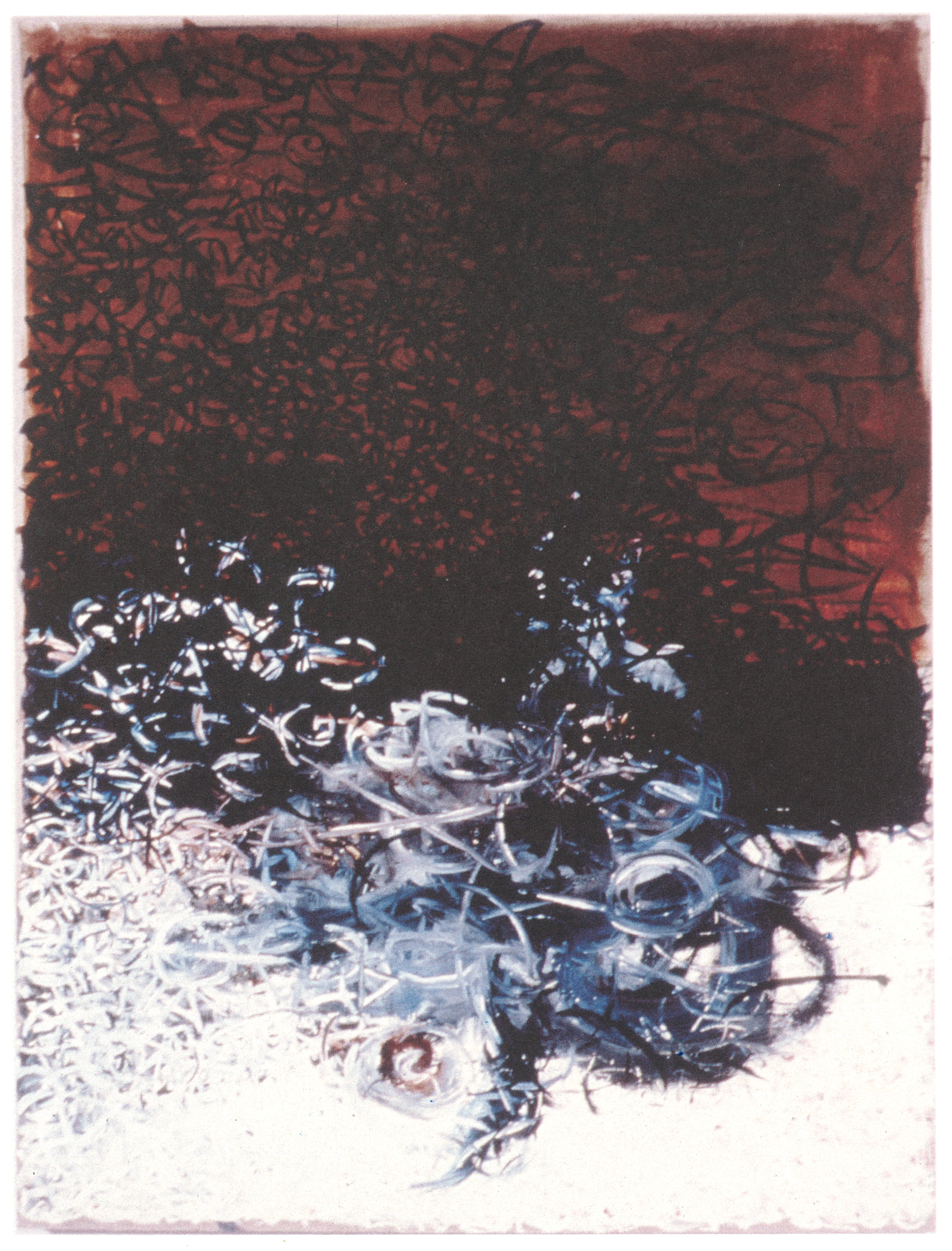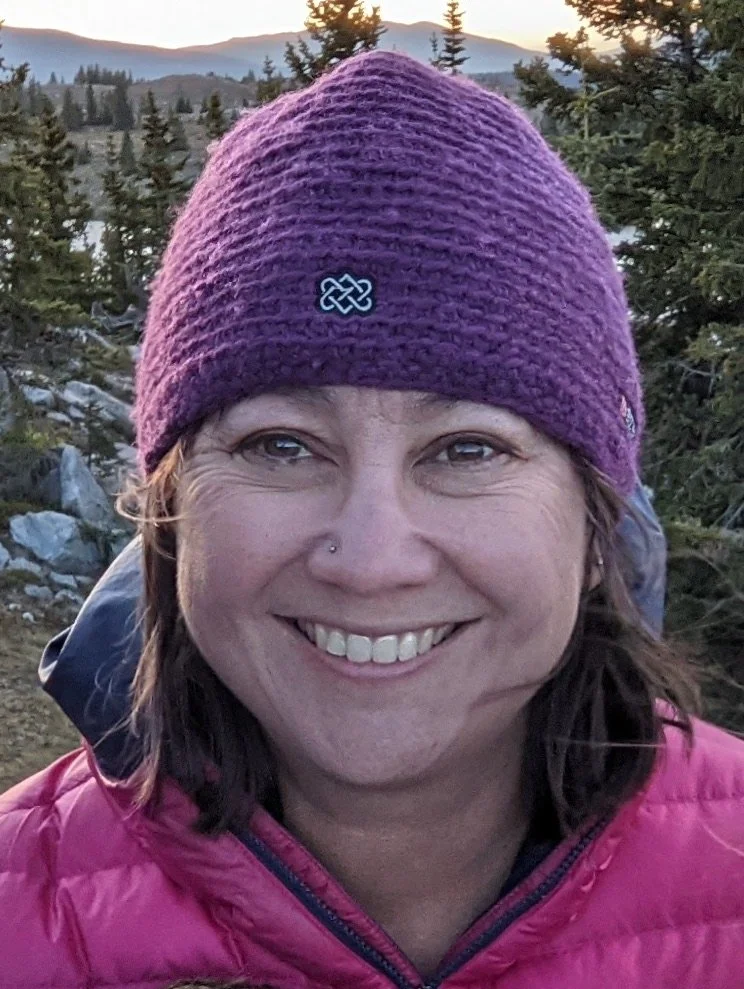Heart Mountain
by Lena (Sunada-Matsumura) Newlin
Canyon and River (1999) by Margot Voorhies Thompson. 70.25 x 54.5 in; oil on canvas. Courtesy of Linda Russo Gallery, Portland, OR. First appeared in HDJ No. 2, Fall 2005.
Dear Great Grandmother Matsumura,
Heart Mountain. The name sounds so exquisite, so idyllic. It sounds like a place where young lovers go to escape. It was given the name by Crow Indians because they thought it looked like a buffalo’s heart; blood pulsing, bleeding down into the valley below. I don’t see a buffalo’s heart; but something in my chest aches in a profoundly solitary way when I see its snow-dusted granite cliffs cast shadows over the windblown prairie, against the backdrop of big Wyoming blue skies, painted with streaks of clouds.
Great grandmother, your daughter told me when I was a child that you and your husband and children were sent to Heart Mountain. I found old papers that said your family number was 18541, that you lived in 1-2-E. Block 1, Barrack 2, Unit E. I didn’t really know what that meant until I was an adult. I remember going there as a child one summer for a camp reunion. I thought camps were supposed to be fun, with watermelon and swimming pools and bonfires and cousins. Staying up late, snuggling under sleeping bags, listening to ghost stories. Why would anyone go to a camp among sagebrush and tumbleweeds and dry wind so strong that you can lean into it with your arms outstretched like a crucifix without falling down? There were people at the reunion that looked like you and your children, with their black and grey hair and dark eyes. But they were strangers to me, recollecting about times before I was born. I mostly remember playing in the dirt with my siblings, tossing rocks into the wind, and then stopping for ice cream on the three-hour drive back home.
As an adult, I have been to Heart Mountain a handful of times. A museum now stands on the dusty land where you spent three years of your life. A museum—carefully curated with photos and artifacts donated by families of those imprisoned—was built to tell your story, and the story of 14,000 Japanese Americans who lived there. On a typical day, the parking lot may hold a school bus full of children on a field trip and vehicles with a half dozen different state license plates.
My picture is in the museum; my mom and I are pointing at the name of your son, Clarence. His name is inscribed on the Honor Roll, a concrete, wood-framed list of more than 800 young men and women who served in the US military while their families were incarcerated, like you, at Heart Mountain. My grandpa’s dog tags are in an exhibit with other war-time mementos, a US Army uniform, a mess kit. Your daughter Bunny’s ice skates sit in a plexiglass case. Donations from our family that we figured would be better appreciated in a museum than in forgotten storage boxes. Black and white photographs cover the walls of the museum and capture moments prior to your forced removal; a diorama depicts what was once the 740-acre camp owned by the United States Bureau of Reclamation. Art made by incarcerees—black and white sketches of camp life, watercolor landscape paintings; audio and video interviews, a model of a barrack with basic living essentials; these are all artifacts in the museum that piece together a mosaic of stories about your life at camp.
Outside the museum, the barbed wire fence no longer fully encloses the camp. Farmland of sugarbeet crops now covers most of the grounds where your tar-paper barracks, the mess hall, open-stall latrines, and the War Relocation Authority administration building once stood. The red brick smokestack from the boiler room of the hospital where 556 babies were born leans into the landscape like an elderly spinal column and can still be seen for miles. The nine guard towers, staffed by US military personnel who allegedly were there for your protection, but whose guns were pointed at you, not away from you, are no longer standing. A single replica casts an ominous shadow over the site.
Great grandmother, I learned that after the camp closed down, you were sent away with $25 and a train ticket and nowhere to go. The original barracks were sold to White homesteaders for a dollar a piece. Many of them became horse stables and barns; many became frames for area residents’ houses and home additions. There is one old barrack that was recently recovered from a private landowner and returned to the camp site for a museum exhibit. Its original single-paned windows and uninsulated plywood walls with rusted nails poking out provide a tactile reminder of the hastily built structures that you were forced to call home.
For a tourist, visiting the museum provides an incredible educational experience, insight into a dark chapter of American history frequently omitted from school curricula. At the giftshop, visitors can buy a book or a postcard or make a donation. For me, though, standing on the hallowed ground where you spent days, weeks, months, years of your life, seeing our family’s artifacts on display, looking at photos of faces that look like yours, knowing that you were forcibly removed from your home and your life in California because of your Japanese ancestry, this all evokes visceral emotions and memories that I don’t recognize as my own.
The last time I was at Heart Mountain, the museum held a special exhibit that tied themes of your incarceration experience to today’s anti-Asian hate and the coronavirus pandemic. Photos of protesters in 2020 holding “Hate is a virus” signs were juxtaposed with photos from 1942 of Japanese American businesses posting “We are Americans” signs in their windows. Posters of Asian American faces bruised and bloodied because of the “Kung Flu” and the “China Virus” looked like you, looked like my mom, looked like my siblings, like me. I felt my nostrils flare and my throat tighten, and I searched through watery eyes for the nearest exit. Because all of a sudden, the girl that grew up in rural White America, with mostly White friends, playing White games and talking White language saw those photos and recognized myself.
Great Grandmother, I live in a modest but comfortable house built in the 1950s in Southeastern Wyoming, along the railroad that your husband probably helped maintain before he retired and moved the family to California. My tan brick house has electricity and indoor plumbing and natural gas heat and insulated walls that keep me and my family warm during Wyoming winters that are known to freeze your eyelashes and nostril hairs. During the summers, grass grows green in my front yard where I throw the baseball with my son in the evenings before the mosquitoes chase us inside. My daughter likes to help me plant our small garden of lettuce and carrots and tomatoes and basil that soak up the summer sun and fresh water from the garden hose. Some years, I harvest enough to share with friends and neighbors. Some years, an afternoon hail storm passes through, stripping the leaves and fruit down to their stems, and within minutes I lose everything that I have cultivated. But our stomachs don’t know the pangs of hunger. I have worked hard in my life, taken on side jobs, lived within my means, and saved enough money so that I can buy my kids something nice every once in a while: a stuffed animal, a new bike, tickets to a baseball game. I can’t imagine what it would be like to lose it all one day, to have it taken away from me, pillaged. All because of the shape of my eyes, the color of my hair, the Japanese blood in my veins. But this is what happened to you, great grandmother; and my heart bleeds like a shot buffalo to think about it.
Yours truly,
Lena
Lena (Sunada-Matsumura) Newlin is a fourth-generation Japanese American, a fourth-generation Wyomingite, and a descendant of Japanese Americans incarcerated on the basis of their ancestry during WWII at Heart Mountain, Wyoming. Her writing appears in the 10th anniversary anthology of DoveTales: A Writing for Peace Literary Journal of the Arts (2021) and in the Spring 2022 edition of Solstice Literary Magazine. She recently left a 22-year career in Public Health to focus on writing a book about her family history. She will begin an MFA program this fall at the University of Wyoming.



